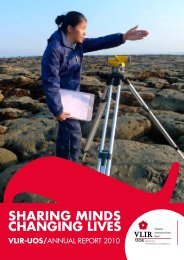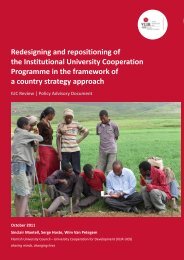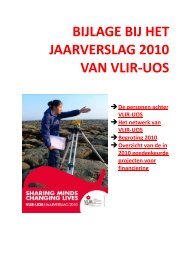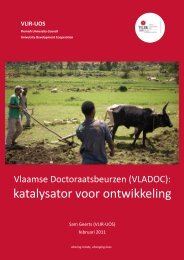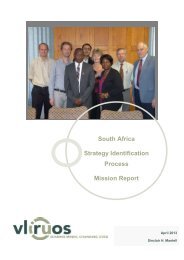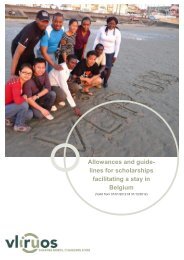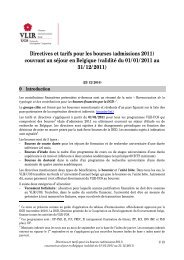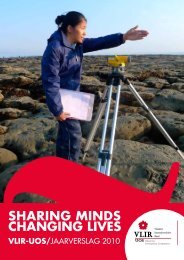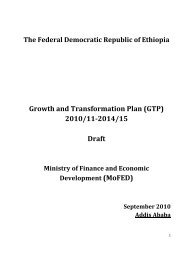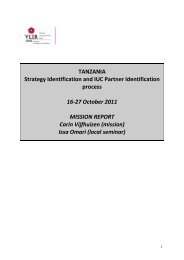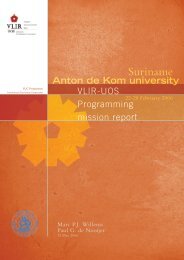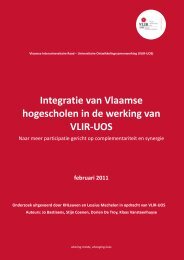Education Sector Development Program - VLIR-UOS
Education Sector Development Program - VLIR-UOS
Education Sector Development Program - VLIR-UOS
You also want an ePaper? Increase the reach of your titles
YUMPU automatically turns print PDFs into web optimized ePapers that Google loves.
<strong>Education</strong> <strong>Sector</strong> <strong>Development</strong> <strong>Program</strong> IV<br />
Improving equity and access in General<br />
<strong>Education</strong><br />
Equity and Access in Early Childhood Care<br />
and <strong>Education</strong><br />
1. Situation analysis<br />
Early Childhood Care and <strong>Education</strong> (ECCE) has<br />
known an important expansion under ESDP III.<br />
Enrolments have grown at an annual rate of<br />
between 8.8% in 2004/2005 to 18.1% in 2008/2009.<br />
There has also been a significant growth in the<br />
number of kindergartens (1,497 in 2004/05 to<br />
2,893 in 2008/2009). This has led to an increase<br />
in the gross enrolment rate from 2.2% in 2004/05<br />
to 4.2% in 2008/2009, with very little difference<br />
between boys and girls. The number of ECCE<br />
teachers has grown more quickly even than the<br />
enrolment, the result being that there has been<br />
a significant decrease in the pupil/teacher ratio<br />
(32:1 in 2004/05 to 16:1 in 2008/2009).<br />
Notwithstanding this progress, the gross<br />
enrolment rate remains low, at 6.9% in 2009/2010,<br />
and enrolment is heavily concentrated among<br />
urban areas (Addis Ababa has a GER of about<br />
50%) and among fairly well-off social groups.<br />
Under ESDP III, the government was expected<br />
to provide incentives to private providers as well<br />
as to rural communities to set up ECCE schools.<br />
However, this has succeeded much better with<br />
private providers than with communities.<br />
In various regions, with the support of development<br />
partners and in close collaboration with the local<br />
communities, an interesting initiative has been<br />
launched with success: it consists of organizing<br />
a pre-primary class within an existing primary<br />
school. This has helped spreading ECCE into<br />
rural areas.<br />
Main challenges<br />
2. Expected program outcomes<br />
❚<br />
❚<br />
• Overall enrolment levels remain<br />
low: national GER at 6.9% in<br />
2009/2010.<br />
• Enrolment is concentrated in<br />
urban areas.<br />
• Few communities succeeded in<br />
creating ECCE centers.<br />
Access to Early Childhood Care and<br />
<strong>Education</strong> increased through formal<br />
and non-formal delivery methods<br />
Provision of ECCE in rural areas<br />
improved, in particular through<br />
coordination, supervision, training and<br />
awareness raising to communities<br />
Key outcome targets<br />
GER for ECCE will increase from 6.9% in 2009/10<br />
to 20% in 2014/15<br />
A pre-primary class will exist in all rural and<br />
urban primary school compounds.<br />
3. Policy and strategies<br />
Under ESDP IV, the government will give<br />
increased attention to the expansion of access<br />
to ECCE. Participating in ECCE helps the young<br />
child prepare for the formal school and succeed<br />
in the early grades. Through an expansion of<br />
ECCE the drop-out rate in early grades, which<br />
is very high in many Ethiopian schools, can<br />
significantly decrease. At the same time, children<br />
who have attended ECCE, more easily acquire the<br />
necessary basic reading and writing skills.<br />
The government’s role in increasing access will<br />
be mainly one of promoting and coordinating the<br />
involvement of other stakeholders, such as private<br />
providers, communities and cooperatives/unions.<br />
The successful pilot program of creating ECCE<br />
classes on formal primary school compounds<br />
will be further promoted.<br />
Special strategies will be developed to increase<br />
the number of ECCE classes and programs<br />
in rural areas. These will consist of providing<br />
incentives to communities, of promoting iddirbased<br />
ECCE owned by low-income communities<br />
and of providing support to stakeholders who<br />
set up ECCE classes in rural primary school<br />
compounds.<br />
Generally speaking, the modes of expanding<br />
ECCE services will be both through formal<br />
and non-formal. The formal delivery will be<br />
through pre-schools owned and managed by<br />
the community and by private entrepreneurs.<br />
The non-formal delivery will be through the<br />
child-to-child initiative, particularly for rural and<br />
pastoralist communities, in which older children<br />
(young facilitators) participate in structured playoriented<br />
activities with their younger siblings<br />
and neighbors’ children. These activities will be<br />
adapted to the local context and fit in with the<br />
child’s daily life. This approach will make use of<br />
students of grades 5 and 6 trained and guided by<br />
their teachers whereby teachers will be involved<br />
as trainers and supervisors, and parents will take<br />
turns and observe. The main aim of the child-tochild<br />
initiative is to better prepare young children<br />
for primary school. It is considered an effective<br />
low cost way of improving school readiness.<br />
31



